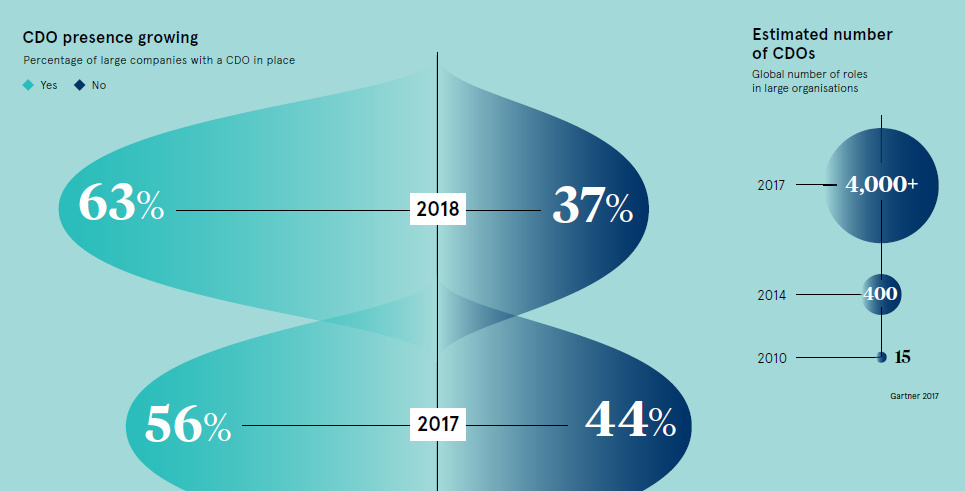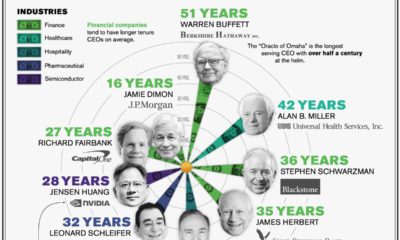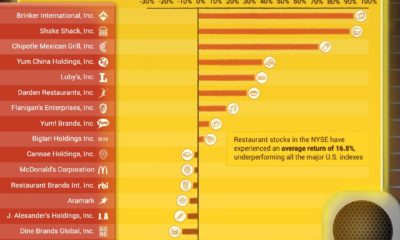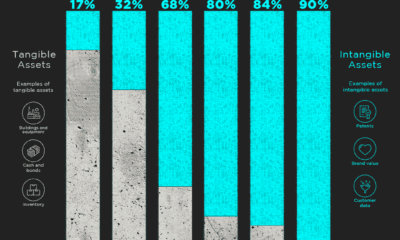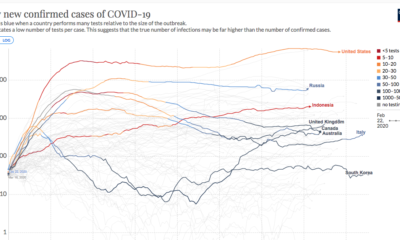In fact, data is so important nowadays that some experts are saying that it’s the most valuable resource in the modern economy, even going as far as describing data as the “new oil”. While not everyone agrees with this kind of hyperbole, it’s fair to say that how organizations approach data will be a major determining factor for future growth and success – and thus, having someone to make the most of data is crucial. To guide these kinds of decisions, many organizations are making a structural change to their C-suite: the addition of a Chief Data Officer (CDO).
The Changing C-Suite
The set of executives that reports to the modern CEO is constantly evolving, and over the last couple of decades we’ve seen the implementation of other tech-focused positions such as the Chief Information Officer (CIO) and the Chief Technology Officer (CTO). The CDO is the newest addition to the mix, and it’s a job that’s responsible for enterprise wide governance and utilization of information as an asset. This includes oversight over data processing, analysis, data mining, information trading, and other means. Today’s infographic comes from Raconteur, and it breaks down organizational perspectives on the role of the CDO, along with how execs in this fast-evolving position are allocating their time to achieve their mandates.
The CDO Mandate
Approximately 90% of large global organizations will have a CDO by 2019, and the general mandate for most CDOs will be as follows: Data Integrator: Raw internal data exploration, diagnostic analytics, and value-added data quality and integration Business Optimizer: External context and benchmarking, cost-reduction analysis, and business-driven growth opportunities Market Innovator: Data monetization, cognitive trend analysis, and innovative business models Meanwhile, Gartner breaks it down in a similar way, suggesting that CDOs spend 45% of their time focused on value creation or revenue generation, 27% on risk mitigation, and 28% on cost savings and efficiency.
Who Makes a Good CDO?
As with any new type of role, there are always questions about how to get someone that is the right fit. Here is the background of successful CDOs thus far, according to NewVantage Partners: Like the constantly evolving landscape of data itself, the role of CDO will keep changing in the future as more organizations search for new ways to make the most of this precious resource. on But fast forward to the end of last week, and SVB was shuttered by regulators after a panic-induced bank run. So, how exactly did this happen? We dig in below.
Road to a Bank Run
SVB and its customers generally thrived during the low interest rate era, but as rates rose, SVB found itself more exposed to risk than a typical bank. Even so, at the end of 2022, the bank’s balance sheet showed no cause for alarm.
As well, the bank was viewed positively in a number of places. Most Wall Street analyst ratings were overwhelmingly positive on the bank’s stock, and Forbes had just added the bank to its Financial All-Stars list. Outward signs of trouble emerged on Wednesday, March 8th, when SVB surprised investors with news that the bank needed to raise more than $2 billion to shore up its balance sheet. The reaction from prominent venture capitalists was not positive, with Coatue Management, Union Square Ventures, and Peter Thiel’s Founders Fund moving to limit exposure to the 40-year-old bank. The influence of these firms is believed to have added fuel to the fire, and a bank run ensued. Also influencing decision making was the fact that SVB had the highest percentage of uninsured domestic deposits of all big banks. These totaled nearly $152 billion, or about 97% of all deposits. By the end of the day, customers had tried to withdraw $42 billion in deposits.
What Triggered the SVB Collapse?
While the collapse of SVB took place over the course of 44 hours, its roots trace back to the early pandemic years. In 2021, U.S. venture capital-backed companies raised a record $330 billion—double the amount seen in 2020. At the time, interest rates were at rock-bottom levels to help buoy the economy. Matt Levine sums up the situation well: “When interest rates are low everywhere, a dollar in 20 years is about as good as a dollar today, so a startup whose business model is “we will lose money for a decade building artificial intelligence, and then rake in lots of money in the far future” sounds pretty good. When interest rates are higher, a dollar today is better than a dollar tomorrow, so investors want cash flows. When interest rates were low for a long time, and suddenly become high, all the money that was rushing to your customers is suddenly cut off.” Source: Pitchbook Why is this important? During this time, SVB received billions of dollars from these venture-backed clients. In one year alone, their deposits increased 100%. They took these funds and invested them in longer-term bonds. As a result, this created a dangerous trap as the company expected rates would remain low. During this time, SVB invested in bonds at the top of the market. As interest rates rose higher and bond prices declined, SVB started taking major losses on their long-term bond holdings.
Losses Fueling a Liquidity Crunch
When SVB reported its fourth quarter results in early 2023, Moody’s Investor Service, a credit rating agency took notice. In early March, it said that SVB was at high risk for a downgrade due to its significant unrealized losses. In response, SVB looked to sell $2 billion of its investments at a loss to help boost liquidity for its struggling balance sheet. Soon, more hedge funds and venture investors realized SVB could be on thin ice. Depositors withdrew funds in droves, spurring a liquidity squeeze and prompting California regulators and the FDIC to step in and shut down the bank.
What Happens Now?
While much of SVB’s activity was focused on the tech sector, the bank’s shocking collapse has rattled a financial sector that is already on edge.
The four biggest U.S. banks lost a combined $52 billion the day before the SVB collapse. On Friday, other banking stocks saw double-digit drops, including Signature Bank (-23%), First Republic (-15%), and Silvergate Capital (-11%).
Source: Morningstar Direct. *Represents March 9 data, trading halted on March 10.
When the dust settles, it’s hard to predict the ripple effects that will emerge from this dramatic event. For investors, the Secretary of the Treasury Janet Yellen announced confidence in the banking system remaining resilient, noting that regulators have the proper tools in response to the issue.
But others have seen trouble brewing as far back as 2020 (or earlier) when commercial banking assets were skyrocketing and banks were buying bonds when rates were low.
